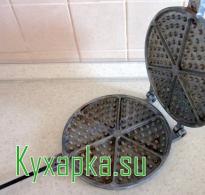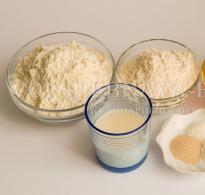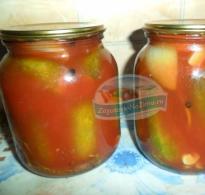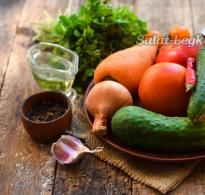Corn can be frozen fresh or boiled. What's the best way to freeze corn?
Delicious juicy corn — favorite treat many not only children, but also adults. Delicate slightly sweet grains go well with various types products, so corn can be added to almost any treat. Salads and appetizers with corn always decorate festive table and will give a lot of joy to the kids.
However, not only for taste qualities this product is appreciated. Corn is very useful plant, which contains very great content vitamins and necessary for a person amino acids.
However, like most healthy fruits and vegetables, corn is a seasonal plant and after harvest autumn harvest in stores you can only buy canned grains. How to preserve corn at home? Is corn frozen? How to properly freeze corn to preserve as much of it as possible useful properties?
If you really want this healthy and tasty product to be on your table, regardless of the time of year, then our advice will be useful to you.
Freezing corn helps preserve not only the beneficial properties, but also the taste and aroma of the fresh plant. Depending on the purpose of the workpiece, you can choose the most suitable freezing method. Freezing corn on the cob is suitable for preparing hot dishes, salads and, of course, independent treats that children love so much. Frozen cobs will need to be placed in boiling water and boiled until tender for 20-25 minutes.
Before freezing corn on the cob, it will need to be thoroughly cleaned of leaves and hairs.
Corn of milky ripeness is suitable for harvesting. Carefully clean the cobs from leaves and hairs, cut off the top and rinse under running water.
Prepared cobs should be wiped dry and placed in plastic bags. Place 2-3 cobs in one bag - the amount you use at a time. Re-freezing is not advisable, so package the corn so that it can be cooked immediately. Place the packaged corn in the freezer, where it can be stored for up to 6 months. For salads and appetizers, you can cut the cob into two or three parts.

To save space in freezer, you can freeze corn kernels.
Freezing corn at home is a simple and not complicated task that will only take you a few minutes.
Thoroughly clean the cobs from leaves and hairs - be sure to wash the corn from dust and wipe it well.
To freeze corn for the winter, you should choose whole, undamaged grains. You can separate the grains with your hands, but if you are cooking a large number of, then it is better to use a knife. For convenience, you can cut each cob into several parts and carefully cut off the grains. Try to cut the kernels as close to the cob as possible.
Place the grains in a bag, close and place in the freezer.

There is another way to freeze corn for the winter. In this case, the corn cobs will need to be blanched.

For this method you will need not only a knife and freezer bags, but also a saucepan with hot water and ice. This freezing method is more labor-intensive, but winter time it is he who will help you save your time. There will be no need to cook blanched corn; just pour boiling water over it and bring to a boil.
Ice can be prepared in special mold- a few hours before preparing, pour water into the mold and place it in the freezer.
Pour water into a saucepan and bring to a boil over medium heat.
Peel the corn cobs from leaves and hairs, remove all damaged kernels and place in boiling water.
You need to cook the corn for 5-7 minutes - make sure that the cob is completely submerged in water, and turn it with a fork if necessary.
Pour water into a convenient bowl or pan and add ice until the water becomes very cold.
Place the boiled corn in ice water, hold for a few minutes and immediately remove to a towel to drain excess liquid.
When the corn is thoroughly dry and cool, use a sharp knife to carefully cut off the kernels, as close to the base of the cob as possible.
To freeze use plastic containers or packages. Place in each bag required amount corn so that when you press the bag, all the grains neatly separate into one layer. This will allow the corn kernels to freeze faster and prevent them from sticking to each other.
Place the bags in the freezer for storage.
What's the best way to freeze corn?
Each housewife chooses the best way to freeze corn. If you have a large freezer and don't want to spend a lot of time trying to homemade, then the method for freezing whole corn on the cob is ideal for you. Corn frozen in this way is no different from fresh corn in any way. appearance, neither to taste.
If you don’t have a lot of space in the freezer, but you don’t have enough time for household chores, you can cut each cob into several pieces and freeze it that way.
If you like to prepare soups and salads with boiled corn, then to save both space in the freezer and your time, the method of blanching the grains is suitable.
Frozen corn is stored very well in the freezer, and it hardly loses its beneficial properties. Special secret preparations frozen corn no - cook it in the same way as regular fresh one.
Do not take more corn out of the freezer than you need - it is not suitable for secondary freezing.
Freezing vegetables is a great way to prepare at home, so prepare as many healthy and delicious products for yourself and your family.
For harvesting, sugar corn varieties of milky ripeness are selected. For long storage You can freeze whole cobs, but freezing the grains will allow you to efficiently load your freezer and provide yourself with an appetizing vitamin supplement for the whole winter. They can be prepared both fresh and blanched. The most practical is a small plastic container for one-time use.
To add piquancy, the frozen product is marinated without even defrosting. Bright sunny grains can decorate any salad, enrich the taste of first and second courses, and vegetable stews.
Ingredients

- 3-4 ears of young corn
- 1 tsp. granulated sugar
- 0.5 tsp. salt
- 0.5 l boiling water
How to freeze corn at home
 1. When purchasing an ear of corn, be sure to burst several of its grains - whitish juice should ooze from them. If this is not the case, then the corn is already mature and you will need to cook it much longer than young corn. Remove leaves from corn cobs and plant fibers, rinse in water. Using a sharp knife, cut the kernels from each cob, being careful not to go too deep so as not to cut off the tough core.
1. When purchasing an ear of corn, be sure to burst several of its grains - whitish juice should ooze from them. If this is not the case, then the corn is already mature and you will need to cook it much longer than young corn. Remove leaves from corn cobs and plant fibers, rinse in water. Using a sharp knife, cut the kernels from each cob, being careful not to go too deep so as not to cut off the tough core.
 2. Pour all the cut grains into a saucepan or cauldron.
2. Pour all the cut grains into a saucepan or cauldron.
 3. Add salt and granulated sugar. Pour boiling water and place the container on the stove. Boil for 5 minutes from boiling if the corn is young, and 25-30 minutes if it is mature.
3. Add salt and granulated sugar. Pour boiling water and place the container on the stove. Boil for 5 minutes from boiling if the corn is young, and 25-30 minutes if it is mature.
 4. Place the corn kernels in a sieve or colander and rinse them ice water. Due to the temperature difference, the shell of each grain will become less dense. Let the remaining water drain out.
4. Place the corn kernels in a sieve or colander and rinse them ice water. Due to the temperature difference, the shell of each grain will become less dense. Let the remaining water drain out.
 5. Place all cooled grains into freezer bags or containers. Tie them or seal them with lids and place them in the freezer for 30 minutes. During this time, the grains will completely freeze. The shelf life of this product is about 1 year.
5. Place all cooled grains into freezer bags or containers. Tie them or seal them with lids and place them in the freezer for 30 minutes. During this time, the grains will completely freeze. The shelf life of this product is about 1 year.
 To add corn kernels to a salad, simply create a marinade based on salt, sugar and vinegar, boiling water, and then dip some of the frozen kernels into it. They are already boiled, so the grains only need to cool in the marinade so that you get tasty and aromatic corn, just like from a can.
To add corn kernels to a salad, simply create a marinade based on salt, sugar and vinegar, boiling water, and then dip some of the frozen kernels into it. They are already boiled, so the grains only need to cool in the marinade so that you get tasty and aromatic corn, just like from a can.
Note to the hostess
1. Cleaning the cob with a screwdriver is much more convenient than with a knife. The flat and moderately sharp edge of the tool deftly pries up the grains, penetrating right into the places where they are attached - the raw materials for freezing are flawless.
2. In African countries, Cuba, Latin America, Mexico and many southern states of the USA, corn is as beloved as potatoes in our country. Not all dishes common in the above-mentioned regions can be prepared from a frozen product, but you can make something. Original version- thick corn soup with Mexican chili: corn kernels boiled in a strong salted broth are mashed, seasoned with pepper, and acidified with tomato. Cubans like mashed corn with boiled chicken and smoked pork, and Panamanians put seafood and pieces in it fish fillet. Why not diversify your diet? exotic delicacies, If base ingredient Is there something in the freezer for them?
3. Those who do not need homeopathic treatment corn silk, usually throw them away after cleaning the cobs. A woman will reconsider her attitude towards seemingly useless waste when she learns that their decoction acts on her hair almost like gelatin: it envelops her in an elastic, invisible shell, protects from ultraviolet radiation, and holds styling no worse than hairspray.
Quite often, housewives are faced with the task of freezing food. Surely everyone has had to freeze something at some point. But not everyone knows how to freeze corn correctly. It is worth saying that this cereal is harvested at the end of summer, closer to autumn. Most people associate corn with hot heat and the summer beach. After all, you can often find this product being sold on the coast. There are several ways to harvest corn for the winter. Which one you choose depends solely on your taste preferences. First, try each of the presented methods and choose the one that suits you.
Freezing grains
How to freeze corn for the winter in individual grains? For this method you will need a saucepan, a deep bowl, ice and water.
First, remove leaves and fibers from the corn. Rinse the cobs under running water and place in a saucepan. Bring the product to a boil and let it cook for another five minutes. Prepare a deep bowl with cold water and ice. Once the cooking is complete, you need to act quickly. Place the cobs in a bowl of ice and let them cool. Cooling should occur immediately.
Grains prepared and frozen in this way can be stored all winter, and at the right time taken out and cooked as required by the recipe.

Freezing raw product
This method will tell you how to freeze corn on the cob raw.
Take the product and clean it of leaves and fibers. Rinse under running water and place on a dry towel or napkin. It is necessary that all the liquid is absorbed into the fabric and you do not get the glaze effect.
Place the cobs on a flat-bottomed plate and place in the freezer. In this form, the product should last for about a day. If the time is exceeded, it's not a big deal. After completely frozen transfer the corn to convenient container for storing food.
Cobs in this form can be stored throughout the winter, but they must be prepared as regular corn without waiting for the product to defrost.

Freezing cooked product
Many people are interested in the question of how to freeze boiled corn for the winter? Everything is very simple.
It is necessary to clean and boil the cobs as usual. After this, let them cool and place them in freezer bags or other convenient storage containers. Place the prepared product in the freezer and let it freeze completely.
After this treatment, you just need to take the required number of cobs and heat them

Freezing corn as an additional ingredient
Many cooks like to add corn kernels to vegetables when preparing any dish. Since you can freeze corn for the winter not only as a separate product, this method will greatly simplify your life.
Wash the cobs and remove the grains. Prepare necessary ingredients. It could be peppers, carrots or potatoes. All ingredients must be cut into small pieces so that later you can immediately begin the cooking process.
Rinse all ingredients and dry on a towel. Mix ingredients and place in freezer bags. Place in the freezer until you need them.
Conclusion
Choose the appropriate method for yourself, which describes how to freeze corn for the winter. Use it and enjoy a delicious summer cereal in a frosty, snowy winter.
Corn is a universal and indispensable product that is served as independent dish, and also added to soups and salads. Nowadays, it has become possible to use corn in cooking at any time of the year, thanks to freezers. Therefore, it is worth stocking up on corn summer time when prices are quite low. This way, you won’t overpay for frozen corn in the winter and save a lot. That's why it's important to learn how to properly freeze fresh corn.
It doesn't take too much effort to freeze corn. Corn is frozen on the cob, in paste form, and also in grains.
Freezing corn on the cob
To do this, the corn is cleaned of leaves and fibers, washed, and placed in cling film or in bags and place in the freezer. You can also cut the corn cob into two pieces if desired.
Freezing corn into a paste
This type of corn is also called creamed corn. To prepare it, corn is prepared in the same way, that is, peeled, washed, and then with a sharp knife, cut off the grains at a distance of 3 millimeters from the edge. When the entire cob is cut off, you need to go through the knife again until only one head of cob remains.
Freezing corn beans
To freeze corn in grains, fibers and leaves are removed from the cobs, washed and subjected to the following processing. You need to put the water on the fire and bring it to a boil, and you will also need ice water, which will need to be placed in the freezer first. plastic bottles. After this, pour the water into a pan, which should be large enough to fit the cobs. Next, put two pans on the table next to each other and first dip the corn in boiling water for 5 seconds, and then put it in ice water, also for a few seconds. This procedure will allow the grains to come off the head very easily. After this, cut off the grains with a sharp knife, closer to the roots of the grains. It is very important not to cut the kernel as this will give the corn an off flavor. After this, we place the corn kernels in plastic bags and place them in the freezer.
Corn is delicious and useful product, which humanity has been using for food for several thousand years. When raw, it can be stored for 1–1.5 weeks. To be able to use the product throughout the winter and spring, it can be frozen. You will find information on how to freeze heads and kernels of corn in this material.
Advantages and disadvantages of freezing
Freezing is considered the best way long-term preservation of products.
- It has the following advantages:
- With this method it is preserved maximum amount valuable elements, taste, juiciness and smell of products.
- Possibility to use the product all year round.
- Cost-effective, no need to spend on additional ingredients.
- Low time consumption.
- The disadvantages include:
- The need to have a spacious freezer.
- The product is unsuitable for re-freezing.
Selecting and preparing corn for freezing
For freezing, whole cobs with intact grains and no wormholes are selected. They should be ripe, but not overripe. The best types to freeze are sugar varieties. Grain crops need to be frozen immediately after harvest: after long-term storage its taste will deteriorate and its juiciness will decrease.
Did you know? According to scientists, corn was cultivated by the Mexicans 7-12 thousand years ago. The cobs were discovered in ancient excavations dating back to 4250 and 2750 BC. e. They are much smaller in size than modern ones.
Before you freeze raw corn on the cob for the winter, you must first prepare it:- Remove leaves and brown fibers.
- Cut off the top.
- Rinse under running water.
- Dry.
When freezing grains, the following preparation is carried out:
- The cobs are cleared of leaves.
- Rinse.
- Dry it.
- The grains are separated from the cobs by hand or cut with a knife.
How to properly freeze corn for the winter
In order for corn to retain its taste and valuable elements during freezing, it is necessary to strictly follow the technology. There are 2 ways to preserve the product frozen: on the cob and in grains. For freezing, you need special bags (the most convenient is with a zipper), plastic containers (for grains) and a freezer that maintains a temperature of –12…–18°C.
Important! In one bag it is necessary to place as many heads of cabbage or their parts as will be used at a time. Repeated freezing of the product is unacceptable.
On the cob
Freezing corn on the cob for the winter is carried out as follows:

Another way to freeze is after blanching. Once removed from the freezer, such a product no longer requires long-term heat treatment. In addition, it retains juiciness.
The technology for freezing blanched corn is as follows:
- Pour water into a large saucepan.
- Place it on the stove and boil.
- Place the peeled heads of cabbage in boiling water.
- Cook over medium heat until the grains are soft (about 7-10 minutes).
- Cool the heads of cabbage at room temperature.
- Place in bags or wrap in cling film.
Important! When freezing heads of cabbage, you need to make sure that all parts are wrapped in plastic. Otherwise, chapping and loss of juiciness will occur.
In grains
This option is good because it saves space in the freezer. Cleaned dry grains should be placed in plastic containers or bags, leveled and frozen. Like cobs, kernels can be frozen after blanching. To do this, you need to first boil the heads of cabbage (we described the technology in the previous subsection), cool and separate the grains. Then you should put them in small portions in bags, release the air, level them into one layer and seal well.
Video: freezing corn kernels
How long can you store
Frozen product can be stored without loss useful substances for 6–8 months: in the future, their number will decrease. The product can be used throughout the year. Thawed corn should be eaten within 1–2 days.
Did you know? Corn is the second most traded grain crop in the world after wheat.
How to use
Corn, frozen on the cob, can be eaten whole or used for preparing first courses. From a product frozen in grains, it is convenient to prepare stews, casseroles, salads, add to children's menu and also used for decoration various dishes and etc. 
Do I need to defrost before use?
If corn is used in dishes with heat treatment, then there is no need to defrost it. It should be immediately thrown into boiling water and cooked until the grains are soft for 20–40 minutes. When using a product that was boiled before freezing, it should be placed in boiling water and boiled for 3-4 minutes. It is also possible to place the heads of cabbage and grains in the microwave, where you should turn on the “Defrost” mode. Frozen grains are added to dishes without defrosting.
Thus, in a great way saving corn for long time is freezing. As a result of this simple procedure, the maximum amount of valuable elements remains in the vegetable. Each cook can decide whether this or that option is convenient for him, because you can freeze corn in several ways: on the cob and in the grains, without cooking and after boiling.






